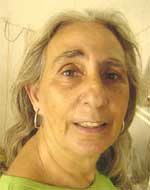
Louise Vogel
At the time, the henequen products that were being produced in the traditional ways were everyday items such as the sabucan used by campesinos to carry their essential tools to the milpa. The government craft organization had begun pushing the villagers to create more commercial "crafts" without supplying much technical or design support. They encouraged the artisans to copy contemporary articles such as placemats with bright colored dyes. These products were sold through the government craft development organization in the official craft store. It was a relatively secure way for the campesinos to have a market for their products. With this secure outlet, craftsmanship began to give way to cottage industries and family co-ops that were producing more and more tourist goods as fast as possible.
My background is in textiles; I have worked as a designer and as a supervisor in quality control for large textile print factories. As technology leaped forward I witnessed the decline of the fabric printing industry. In the Yucatan, I could see a similar situation on the horizon since traditional articles were disappearing, falling out of use because they did not have sufficient commercial appeal.
The challenge of finding ways to use traditional techniques while making beautiful crafts enticed me. My first challenge was to take the basic sabucan and devise ways to make it more attractive without changing the basic techniques or the basic structure. My first designs were well received. To continue, I knew I had to work directly with the village weavers and to learn all I could about their craft.
Visiting small towns and remote villages with Clementina Iuit, my long standing friend, Maya interpreter, and partner in this adventure, I made trips into the countryside. We discovered and still discover new, delightful things along the way.